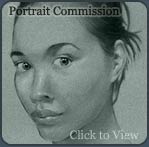Horses and Movement |
||||||||||||||||
|
Page 07 / 07
To return to the question of loss of definition and apparent deformation of shape, it is interesting to notice how it can make for beauty. In a scientific cinematograph there was shown upon the screen a bullet in the act of striking an egg-shell dancing on a jet of water. To make it visible the speed of nature's movements was reduced so that the little black bullet crawled quietly across the screen to where the egg-shell lifted slowly up and down upon the weary column of water. It was very curious to see it deliberately push the egg-shell over and by so doing disturb the water-jet, which had to make two or three laboured efforts to recover itself. But from our point of view the interesting effect was the appearance of the drops of water. They were not the gay sparkling jewels we all admire. They were repulsive protoplasmic viscous-looking things, slowly changing from one ugly shape to another as they sank through the air. Is not the visual world then partly dependent for its beauty on its speed ? Are not the drops of water rather like discords in music, pleasant to look upon, as the others are to hear, when passing at their proper pace ? 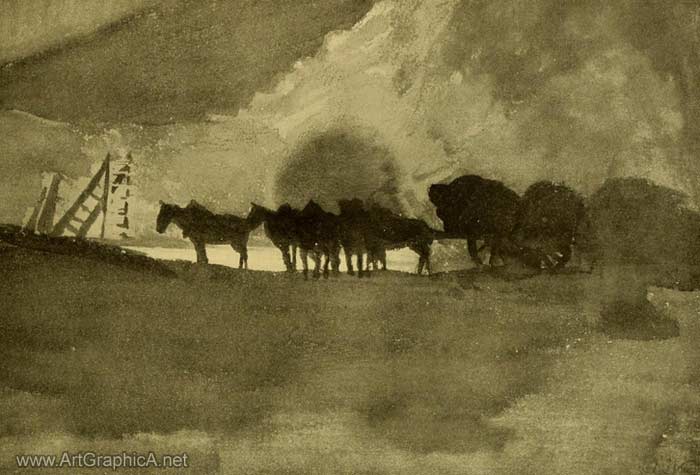 NIGHT WORK. Horse art, drawing. Since art is art and not nature, is there not a certain measure to be observed in what is represented ? There are many optical effects which are not satisfactory when presented persistently, as they are in a work of art. The head of a dog as it shakes itself on coming out of the water leaves a confused blur upon the eye that is too transient in nature to be satisfactory in a picture, and yet it is not very different from the distorted and ever- varying images of objects reflected in undulating water, which are quite acceptable when represented in a picture. Is it upon the effect being sufficiently persistent that the question turns -- that the disappearance of the spokes of a wheel from taking place about a centre has, like the reflections in water, a certain constant character which makes the representation of a wheel without spokes quite satisfactory ? 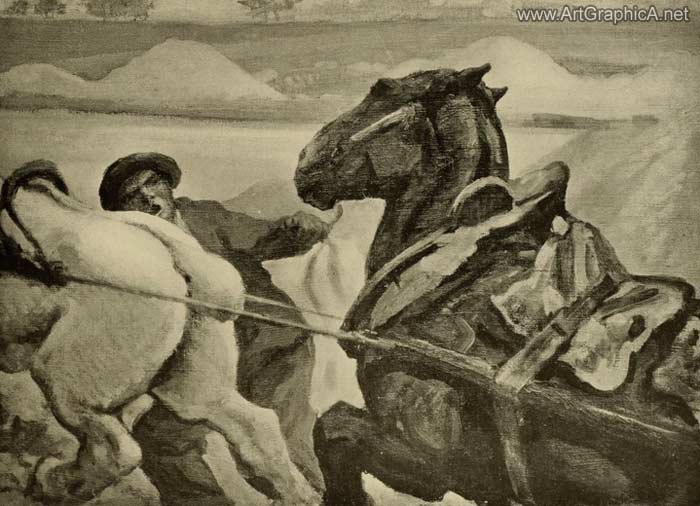 THE BLACK HORSE. Horse art, drawing.
To take a few clear instances from pictures in the National and Tate Galleries. Horizontal and vertical are the principle of Turner's " Chichester Canal," varied with a few gentle curves, of De Hooch's " Interior," of Crome's " Mousehold Heath " which is divided into two almost equal spaces of moorland and sky by a straight horizontal line, relieved by the cart tracks and a slight movement of the clouds. For contrast look at these three turbulent pieces -- Turner's " Shipwreck," Rubens' " Rape of the Sabines " and Tintoret's " Milky Way." Rough diagrams are given of these six pictures for those who cannot refer to the originals. The light and shade is left out and the emphatic parts of the pattern are translated into line. 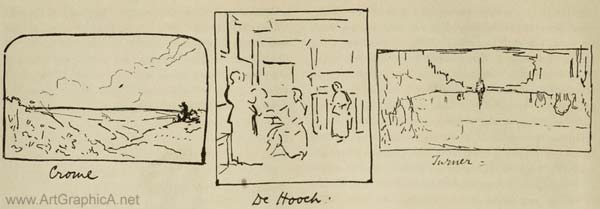
They do not claim to be accurate, being only rapid sketches from small reproductions, yet they make, I think, the characteristic difference of the two groups sufficiently evident. The reader will remember that it was suggested that he should look at certain pictures upside down in order to observe the pattern for itself. Some of these diagrams -- lie will easily detect which -- are reproduced upside down the better to illustrate the principle of effect inherent in mere pattern. 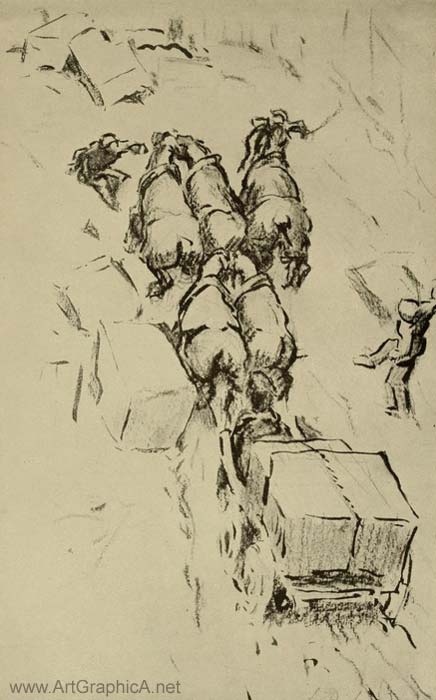 STONE-CART, BIRD'S EYE VIEW. Horse art, drawing. Such differences are fundamental and are true to nature, being based upon what we see and experience every day. To test the visible repose of vertical and horizontal in nature tilt the picture frames and notice the restless effect that is immediately produced. You can't stand at an angle, nor can you push or pull as long as you remain upright. To push a thing you must lean towards it, else the thrust of your arms will push you over ; and when you run you must incline your body forwards, or your legs will outrun your body and you will fall upon your back. 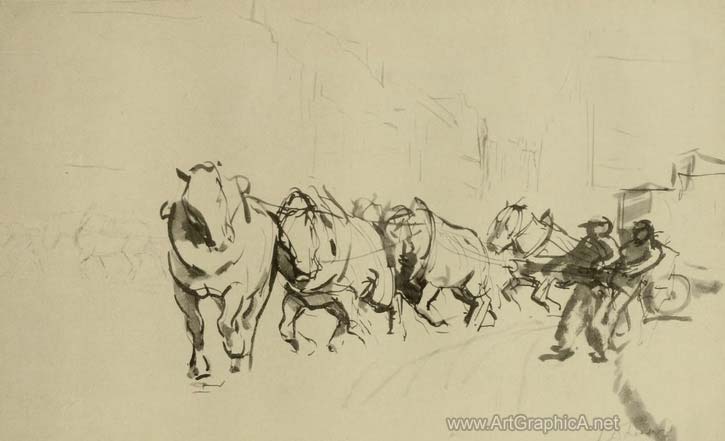 TURNING THE CORNER: FRENCH STONE-CART. Horse art, drawing. The horse leans forward into his collar, and back into his breeching ; the driver leans against the cart to help it up the hill. In principle, walking, running, pushing are partly falling, and, as such, are inclined between the vertical and horizontal, the habitual positions of repose ; and the artist, following nature, instinctively uses in pictures of motion patterns that are neither upright nor prone. 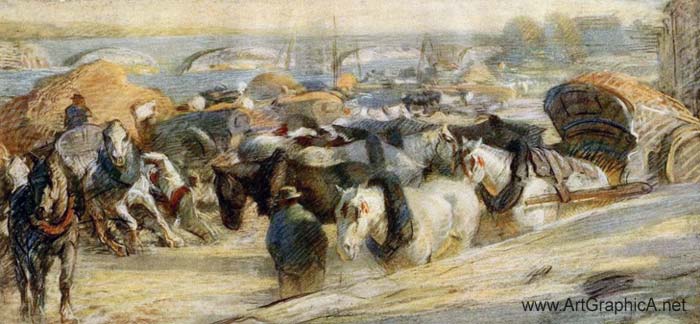 THE SUNNY QUAY. Horse art, painting. If in discussing movement I have confined myself practically to discussing it from the point of view of line patterns it is because rhythm, which is the essence of all movement, implies direction, and of direction the simplest expression is line. 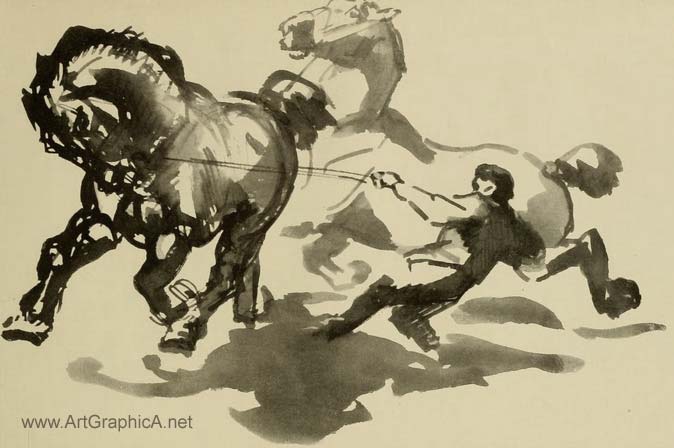 LED HORSES. Horse art, drawing. Spacing, tone, colour, handling and other qualities have, of course, their place in heightening the effect of movement. There must be a sympathy between them and the rhythmic pattern of the picture. In the Tintoret, the Rubens, the " Shipwreck," there are sharp contrasts of tone and colour which would be out of character in the three quiet pictures. Is there not in this a consistency true to nature ? 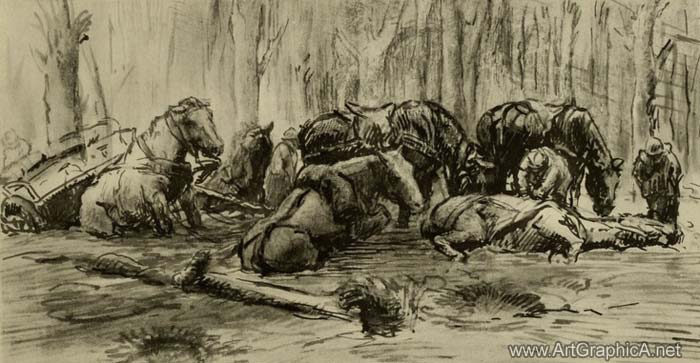 DEAD BEAT, FRENCH ARTILLERY HORSES, THE SOMME 1916. Horse art, drawing. When we watch a scene of rapid movement or vigorous action only the stronger variations of tone and colour are to be observed by the eye. Is, then, the expression of movement a blunter and a coarser art ? Does true refinement occur only in quiet things ? Is not the answer yes and no ? For if refinements of form and spacing and delicate gradations of colour and texture are best to be enjoyed through the contemplation of things at rest under an even lighting, there are other refinements of beauty which are only born of movement. 
An artist must decide for himself what rhythmic patterns will best express his impressions of particular movements, and how far he shall make use of such phenomena as we have been discussing. That is, he should let his eye decide for him. It will select by recollection what it was that interested him, and what, therefore, he will need to master for his work. Accordingly, he may prefer only to observe figures under movement and never to make studies from the model, or he may decide to study anatomy in order to acquire a knowledge of the bones and underlying structures, or, again, rely for such knowledge on observation of the surface alone. Instantaneous photography, which is the anatomy of movement, bearing much the same relation to it that the skull does to the face we see, might be useful to him, but it would be, I should say, a treacherous ally. If we look at the studies and sketches of those who could seize nature on the wing and render her effects, we shall find that they mostly worked through unflagging observation helped out with quick notes, shorthand records often legible to themselves alone. They amplified such slight notes through knowledge of the form and the movements of the figure, either taking such knowledge from their general stock or specially acquiring it for a particular subject. For this purpose some of them make minute and elaborate studies from the model, like Degas ; others, like Daumier, depend apparently upon repeated observation and memory alone. 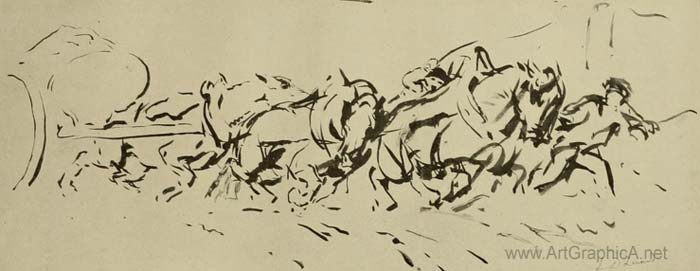 AN EFFORT. Horse art, drawing. Observation seems to be the keynote, the passive observation which does not start out, having settled in advance what it wants to see, but is ready to see what nature will disclose. Nature, as a great artist said, will give to each man according to his powers, if he will but sit humbly at her feet. 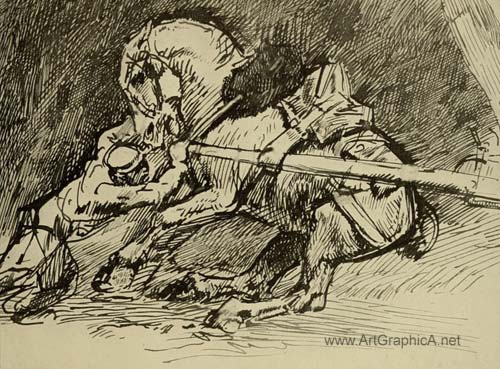 BACKING. Horse art, drawing. Such an attitude is surely the right one in all arts, and the fun of it is that the artist whose preference is against movement will be led, quite rightly, to turn his back upon it and upon all that we have been discussing, and perhaps go off with the gentle Chardin to share the charm of contemplation almost Oriental in its quiescence. As movement, however, can only be perceived through recollection of its phases, it is not possible, as has been already pointed out, to draw it from a stationary thing. It can never be copied from a posing model, for there it does not occur. A good illustration of how not to do it is given by Verestchagin in his recollections of Meissonier. He tells us that when painting a horseman riding against a strong wind Meissonier had a little model with the costume and accoutrements of horse and rider made to scale in their proper materials, that he might have before him the correct details, and the rider's cloak was stiffened with gum so that it stood out in the position of a cloak blown by the wind ! I think we may fairly ask would Meissonier, if he could, have stiffened the trees in the landscape so that they would remain in the position of trees blown by the wind ? 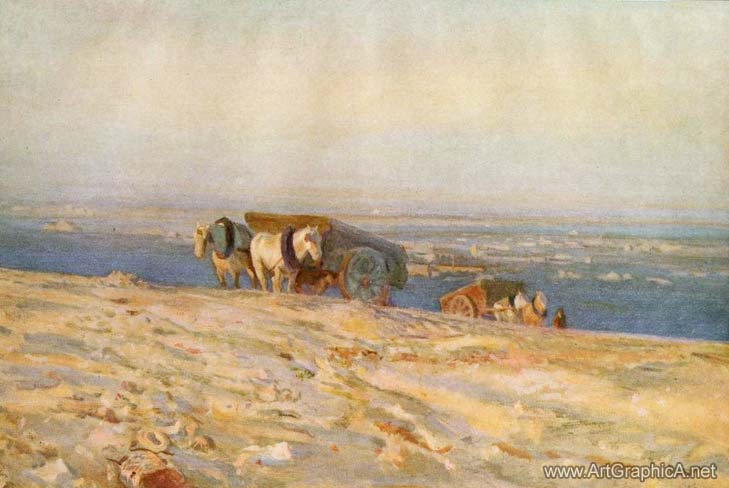 ON THE HILL-TOP NEAR PARIS. Horse art, painting. No ripple on the grass or water, no quiver of a bough or leaf ! Think how you would enjoy your walk in such a scene ! Think what a landscape picture you would paint from it 1 Surely Corot is right in his attitude when he says, " Although when I was young it annoyed me that the clouds would not keep still, now I am glad they will not, for therein lies their beauty "! 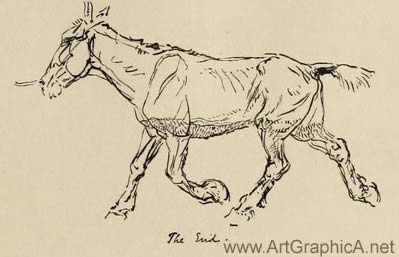
L. D. L. Paris. THE END
Next
Prev PageArt Books Animals in Motion
|
||||||||||||||||
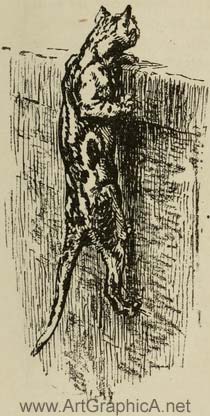 An artist who is constantly watching and enjoying motion like Degas, to whom such changes are familiar, and who accepts them as part of natural appearances as simply as he does the difference of form in a muscle at rest or in action, will necessarily introduce them into his work, either so subtly as to pass unperceived by most people, or so frankly as to shock and distract some spectators. And however much he may use the posing model in order to acquire knowledge of form and construction, he will never substitute its shapes for those he had observed in motion. Sometimes one sees a figure which is meant to express movement drawn with all its muscles tense. The model, not the artist let us hope, no doubt thought he was showing the beauty of his limbs, and did not appreciate that to make the muscles on opposite sides pull against each other is to prevent all movement, and is only used in life when we want to hold a limb absolutely rigid.
An artist who is constantly watching and enjoying motion like Degas, to whom such changes are familiar, and who accepts them as part of natural appearances as simply as he does the difference of form in a muscle at rest or in action, will necessarily introduce them into his work, either so subtly as to pass unperceived by most people, or so frankly as to shock and distract some spectators. And however much he may use the posing model in order to acquire knowledge of form and construction, he will never substitute its shapes for those he had observed in motion. Sometimes one sees a figure which is meant to express movement drawn with all its muscles tense. The model, not the artist let us hope, no doubt thought he was showing the beauty of his limbs, and did not appreciate that to make the muscles on opposite sides pull against each other is to prevent all movement, and is only used in life when we want to hold a limb absolutely rigid.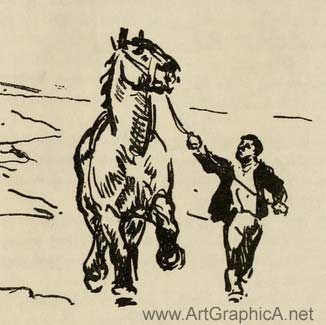 It is interesting to notice in connexion with the means of expression the difference of principle in the composition of pictures of movement and pictures of repose. In pictures expressive of repose the dominant principle of composition is a structure of verticals and horizontals, in a picture expressive of movement the composition is diagonal.
It is interesting to notice in connexion with the means of expression the difference of principle in the composition of pictures of movement and pictures of repose. In pictures expressive of repose the dominant principle of composition is a structure of verticals and horizontals, in a picture expressive of movement the composition is diagonal.







